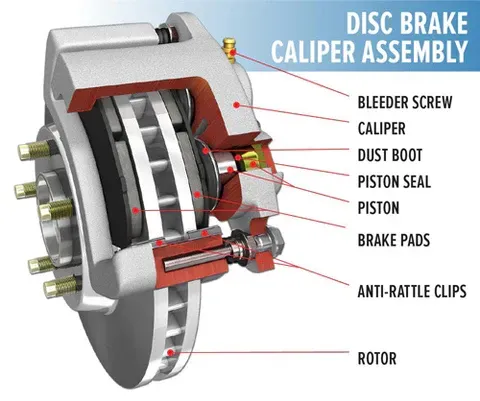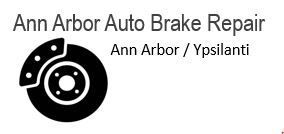When Should My Brake Caliper Get Serviced?

Understanding the Brake Caliper
Most automobiles today have disc brakes for the front wheels and disc or drum brakes for the rear wheels. Brake calipers only appear in vehicles with a disc-braking system. In a disc brake system, the car's wheels are attached to metal discs, also called rotors, that rotate when the wheel rotates, and the brake caliper straddles that rotor with brake pads on each side of the rotor. The brake caliper's job is to slow the car's wheels by clamping brake pads on the rotor, creating friction that brings the vehicle to a stop. Brake calipers are essential to your car's ability to stop and are arguably one of the most important automobile brake parts.
Why the Brake Caliper Matters
When you step on the brake pedal, brake fluid is pushed from the master cylinder and creates hydraulic pressure on one or more pistons in the brake calipers, forcing the captured brake pads against the rotor. In the disc brake system, the brake caliper fits over the rotor like a clamp, while inside each caliper is a pair of brake pads (metal plates bonded with friction material), positioned on each side of the rotor. The outboard brake pads are those on the outside of the rotor and are closest to the curb, while the inboard brake pads are those on the inside of the rotor and closest to the center of the vehicle.
The caliper performs it’s task as long as the brake pads are clamped onto the rotor as controlled by the hydraulic pressure in the line. The factors in properly working brake calipers include pistons that move freely within their channels, brake pads that glide along the slides, and a caliper frame that keeps brake pads square to the rotor under braking pressure, even when aged.
Two Main Types Of Brake Calipers:
Floating/Sliding Calipers
Floating calipers can move in and out relative to the rotor and may have one or two pistons only on the inboard side of the rotor. The piston in the caliper pushes or adjusts the positioning of the entire caliper when the brakes are applied, enabling an equal application of friction from the brake pads on both sides of the rotor.
Fixed Calipers
Fixed calipers (as the name implies) don't move, but rather have pistons arranged on opposing sides of the rotor. Fixed calipers are generally preferred for their performance, but are more expensive than the floating kind. Some high-performance fixed calipers have two or more pairs of pistons arranged on each side of the rotor — some may have as many as six pairs of pistons total.
Brake Caliper Tool
Brake pads don't last forever, and get thinner as they wear away from normal usage. Every time the pads in a disc brake system come in contact with the spinning rotor, they wear down a little. Gradually, these brake pads become thinner and thinner. As the pads wear, the pistons will index further outward, to compensate for the thinner brake pads, to enable expected brake performance, even from brake pads with significant wear. Eventually, the brake pads will be considered too thin and need to be replaced with fresh, unworn pads. When replacing worn brake pads, a special tool will be required to push or retract the brake piston back to its home position to accommodate the new and thicker brake pads. The piston can't simply be pushed back into the caliper because it's threaded, like a screw, and needs to be wound back in.
When To Replace Brake Calipers
When brake calipers are worn out or have gone bad, there are many symptoms that point to the need to inspect and possibly change a bad brake caliper. Poorly working brake calipers often cause uneven brake pad wear, caused by sticking caliper slider pins. The reason pads wear unevenly is because the pads will be partially and artificially applied (even if not being actively applied by the driver), causing them to drag across the rotor.
The following symptoms may be noticeable when a brake caliper has become damaged:
Pulling to one side - A seized brake caliper or caliper with improperly working sliders can cause the vehicle to pull to the right or left side while braking. This same condition may also cause the vehicle to pull to the right or left while driving down the road.
Observed fluid leaks - Brake caliper pistons, which are activated by hydraulic fluid, can develop brake fluid leaks from the piston seal or bleeder screw.
Spongy/soft/abnormal brake pedal experience - A caliper that is leaking brake fluid can cause a spongy or soft brake pedal feel. A seized piston or sticking sliders (discussed above) may also cause abnormal pedal feel due to excessive clearances between the brake pads and the rotor.
Reduced braking ability – Any of the above brake caliper issues may cause your vehicle to exhibit a reduced braking performance.
Dragging sensation - A stuck brake caliper can cause the pads to be pressed against the rotor while driving. As a result, the car may exhibit a dragging sensation, since the brakes at the affected wheel are applied (or partially applied) at all times, even when the vehicle is being driven.
Grinding/Abnormal noise - A sticking brake caliper will wear down the brake pads, which will eventually produce the familiar sound of grinding brakes.
Since a vehicle may experience other problems that can mimic a bad brake caliper, it is important to have your brake system (and calipers, especially) when you start to experience any of the above issues. It is important to not gamble with your brakes if you believe that they are exhibiting signs of trouble. A seized or sticking brake caliper can lead to partial or complete loss of braking ability. If your vehicle is exhibiting any of the symptoms above, bring your vehicle in to Ann Arbor Auto Brake Repair for an inspection and any needed maintenance. Call us up at (734) 537-7344 or request a quote at Ann Arbor Auto Brake Repair today.Better to fix a small issue at a small cost than to fix a more extensive issue at a much larger repair price. We are happy to look into things for you and ensure your peace of mind in future drives.
